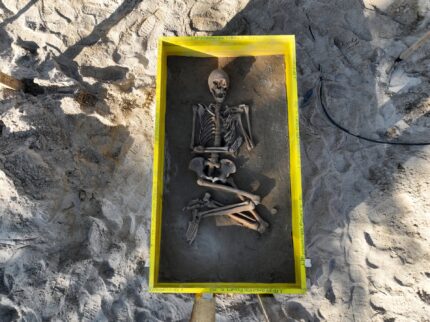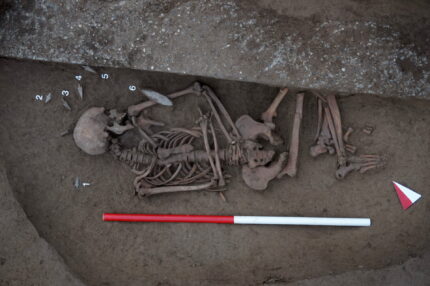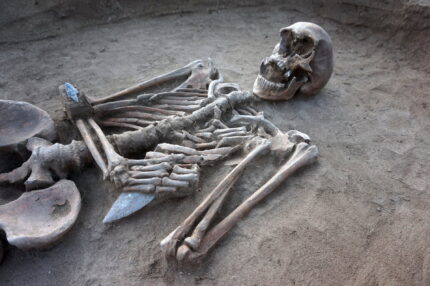 A large Copper Age necropolis has been discovered in the burg of San Giorgio Bigarello on the outskirts of Mantua. It dates to around 5,000 years ago. The quantity of graves and the finely crafted weapons found in some of them were unexpected, and examination of the burials is expected to shed new light on the prehistoric peoples who inhabited of this area of northern Italy.
A large Copper Age necropolis has been discovered in the burg of San Giorgio Bigarello on the outskirts of Mantua. It dates to around 5,000 years ago. The quantity of graves and the finely crafted weapons found in some of them were unexpected, and examination of the burials is expected to shed new light on the prehistoric peoples who inhabited of this area of northern Italy.
In the Neolithic (ca. 6000-4,000 B.C.) and Chalcolithic (ca. 4000-1700 B.C.), the area that is now Mantua was part of the River Mincio basin. The outskirts of the modern city were the shores where people actually lived and died. The famous Neolithic double-burial, the Lovers of Valdaro, were found in San Giorgio Bigarello, so it is known to be archaeologically significant.
 The first human skeletal remains were found in November in an archaeological survey at the site of a future city park. A follow-up excavation unearthed three inhumation burials about 16 inches under the surface. Fortunate happenstance had left the site undisturbed by agricultural work of urban development, and the sandy soil preserved the bones in excellent condition. Two of the burials included grave goods: flint arrowheads and a flint knife blade.
The first human skeletal remains were found in November in an archaeological survey at the site of a future city park. A follow-up excavation unearthed three inhumation burials about 16 inches under the surface. Fortunate happenstance had left the site undisturbed by agricultural work of urban development, and the sandy soil preserved the bones in excellent condition. Two of the burials included grave goods: flint arrowheads and a flint knife blade.
Most of the burials excavated at Bigarello are simple individual inhumations, the deceased placed on their left sides with legs bent to their chests and heads oriented to the northwest. These characteristics are also seen in burials of Neolithic cultures in northern Italy, and some of the grave goods found in the Bigarello graves — flint weapons, hematite beads — are found in Neolithic burials as well.
 Excavations resumed in January, and since then another 19 graves have been found, confirming archaeologists’ suspicions that this was a cemetery, not a handful of random burials. More flint arrowheads and blades have been found in the 19 newly-discovered burials. They are of exceptionally high quality — sharp, even, so light they are practically translucent — and can only have been crafted by people of great technical ability and experience.
Excavations resumed in January, and since then another 19 graves have been found, confirming archaeologists’ suspicions that this was a cemetery, not a handful of random burials. More flint arrowheads and blades have been found in the 19 newly-discovered burials. They are of exceptionally high quality — sharp, even, so light they are practically translucent — and can only have been crafted by people of great technical ability and experience.
Archaeologists are continuing to explore the site. Meanwhile, the skeletal remains and grave goods are being removed to Palazzo Ducale complex in Mantua for further analysis and conservation. There has been some discussion of creating a dedicated museum to house the finds and make them more accessible to visitors.